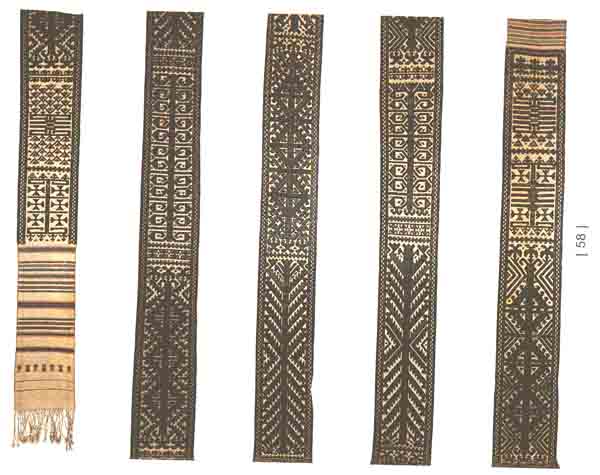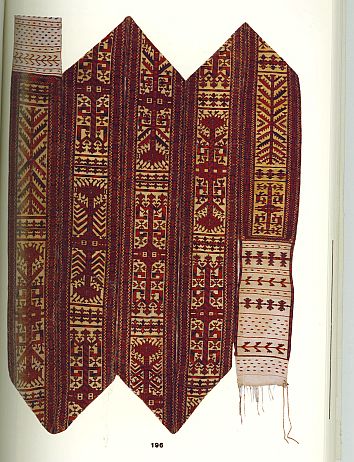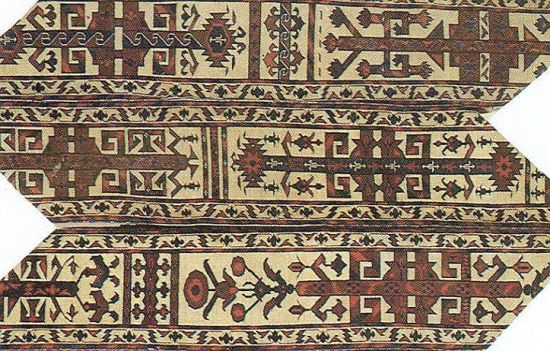Posted by Tim Adam on 09-13-2006 09:19 PM:
Full-pile tent bands
Hi everybody,
Some time ago the following full-pile tent band fragment surfaced on eBay.

It's dimensions are 21 x 12.5 inches. Here are two more detail shots.


Full-pile tent bands are extremely rare, and I was somewhat surprised to see
one with such mechanical drawing as in the eBay piece. However, maybe full-pile
tentbands become less rare as we progress in time?
Given the mechanical drawing I'd think this tent band is probably not very old.
Would anyone have a guess as to the tribal attribution?
For comparison, I am posting images of published full-pile tent bands. The first
one is the famous Thompson tent band, attributed to the Yomud. It is symmetrically
knotted and 14 inch wide.

Interestingly, in 1993, Thompson writes that only 5 full-pile tent bands are
known. All of them are symmetrically knotted and have stylistic details that
suggest a Yomud origin. One then wonders what Thompson thought of Cassin’s tent
band, which was published in 1988. It’s asymmetrically knotted open right and
12 inch wide.

A similar full-pile tent band is published in “Wie Blumen in der Wüste”, and
attributed to the Pseudo-Chodor tribe. It is asymmetric open right and 13.7
inch wide.

Another full-pile Yomud tent band can be found in “Turkmen” by Mackie and Thompson.
It’s width is 11 inch.


The last full-pile tent band I found is from Barry O’Connell’s website, and
attributed to the Chodor.

Does anyone have images of any other examples?
Regards,
Tim
Posted by Steve Price on 09-13-2006 09:56 PM:
Hi Tim
The Cassin band and the "Pseudo-Chodor" (whatever that means) in "Wie Blumen
in der Wuste" are the same piece, and the difference in reported widths must
be an error in one or the other source. What looks like a pretty significant
difference in color reflects photographic and/or printing issues.
Regards
Steve Price
Posted by R. John Howe on 09-14-2006 08:19 AM:
Tim -
I don't have an image of it but Walter Denny had a short full-pile tent band
fragment on a coffee table at his home a few years ago when I visited with a
NYC Hajji group.
I think all full-pile Turkmen tent bands have symmetric knots tied on alternate
raised warps. The pile areas of the mixed technique Turkmen tent bands have
this same structure.
This is also the structure used to make the quite different Uzbek "julkhyrs"
(bearskin) and it is the structure used in the pile areas of a horsecover (think
yellow and orange) I have from the Siirt area of Turkey.
Regards,
R. John Howe
Posted by Steve Price on 09-14-2006 08:51 AM:
Hi John
The full pile tentband that formerly belonged to Jack Cassin, later exhibited
at the Hamburg ICOC (catalog of that bizarre exhibition was published as "Wie
Blumen in der Wuste") is knotted asymmetrically, open right, according to Cassin's
description in Tentband/Tentbag and Rautenstengel's description in "Wie Blumen...".
I think it's probably really asymmetric open right.
Regards
Steve Price
Posted by MarvinAmstey on 09-14-2006 11:06 AM:
There is another intact, full pile band in an Edelmann catalog from 1979 or
1980. When I saw it at the auction house it was in pristine condition and about
10-12 inches wide. I can not lay my hands on the catalog. If some one has the
image, it would look good (better) along side the ones shown here.
Posted by R. John Howe on 09-14-2006 03:41 PM:
Hi Steve -
It would be interesting to see an asymmetric knot tied on alternate raised warps.
You can see why weavers would tend to use symmetric knots. The fact that the
distance between the warps on which the knots are being tied is greater than
usual would tend to make the entire assemblage more unstable, if assymetric
knots are employed.
On the other hand, most (all?) of the pieces in the recently opened TM exhibition
of classical Persian carpets are from Khorasan. There the jufti knot, tied over
four warps, is the traditional one. But the jufti knot used in these very old
Khorasan carpets is asymmetric open left. I'd guess the distance involved in
using jufti knots is at least as great as those when one ties on alternative
raised warps.
So perhaps choice of knot is not as related to the set of warps employed in
that way I have thought.
Regards,
R. John Howe
Posted by Jerry_Silverman on 09-14-2006 05:33 PM:
Marvin,
I don't have the 1980 Edelman catalog, but in the November 1979 catalog there's
a complete Yomud tent band on a page of its own. Unfortunately, Edelman's color
reproduction leaves something to be desired. It's so crummy I can't tell if
this is pile on a flatweave ground or all pile. And the description doesn't
help at all.
"Yomud Tent Band, Turkestan, Late 19th Century
The ivory ground containing a great variety of ascending geometric shapes including
ram's horns, diamond latchhook medallions, trees, leaves and flowers in colors
of rust, blue, brown and ivory, within a zigzag border and two minor borders.
Approximately 43 feet (13.11 m.) x 1 foot 3 inchs (.38 m.)"
The estimate was for between $8 - $12,000.

Note: I adjusted the brightness and contrast - still not terrific, but better
than it was. Steve Price
I don't know if this is the piece you remember or whether there was another
in the 1980 auction. But I thought I'd post it anyhow.
Cordially,
-Jerry-
Posted by Richard Larkin on 09-14-2006 08:26 PM:
wow
Tent band gurus:
I know we don't get much into the specific financial details of our hobby, but
do these tent bands command $8,000 to $12,000 these days?
__________________
Rich Larkin
Posted by Steve Price on 09-14-2006 10:02 PM:
Hi Rich
A nice complete tentband done with pile on a flatwoven background would probably
be in that range at the major auction houses. The full pile ones sell for very
much more - I think there are less than 10 complete full pile tentbands in captivity.
On the other hand, the format of sequential compartments makes fragments that
are often very attractive and interesting, and there are enough of them around
to be within reach for collectors of more modest means.
Regards
Steve Price
Posted by Richard Larkin on 09-14-2006 10:16 PM:
Thanks for the info, Steve.
__________________
Rich Larkin
Posted by Tim Adam on 09-15-2006 06:32 PM:
Hi guys,
I found one more full-pile tentband. Enjoy.

For a much larger image, see
http://www.turkotek.com/show_and_tell/Tentband5.jpg
(I'll post more info about it later.)
Tim
Posted by Matheus Osalhyrir on 09-15-2006 08:25 PM:
that looks alot like one published in tsareva's 84 publication i believe...
others in there as well.
Posted by Tim Adam on 09-15-2006 10:01 PM:
The tentband I just posted appeared in "Seltene Orientteppiche VIII" by Eberhart
Herrmann (plate 105). It's attributed to the Yomut, symmetrically knotted, and
11 inch wide. I can add more structural info if someone is interested.
This band seems to be similar to the one published by Mackie and Thompson, but
with an even more refined drawing. Actually, I think it is one of the most beautiful
items ever created by Turkmens.
Unfortunately, Herrmann does not have anything enlightening to say about this
band. But he cites a few further references. Maybe someone who has access to
them could check them out and report back.
- McCoy Jones/Boucher 1973, Nr. 38
- Mackie/Thompson 1980, Nr. 1 (see image above)
- Edelmann Galleries, New York, auction catalog from Oct. 24, 1981, lot 198
- Grogan 1984, Tf. XV
Herrmann further writes that six bands of this genre are know, of which three
have been published.
Tim
Posted by Steve Price on 09-16-2006 06:04 AM:
Hi Tim
That (the last one you posted) is a very striking and elegant piece. The floral
motifs in the field and borders are much more natural looking (for want of a
better term) than what I'm accustomed to seeing in Turkmen pile weaves.
Regards
Steve Price
Posted by Marvin Amstey on 09-16-2006 10:36 AM:
Jerry, That's not it. I remember that it covered two pages and was labelled
as full-pile. I also remember that it sold for $12,000 then. Sorry that I can't
be more specific.
Posted by Tim Adam on 09-16-2006 10:45 AM:
Hi Steve,
The floral motifs in the field can also be found on some main carpets. Take
a look at plate 67 in Mackie & Thompson. The same design appears in the
elems. But due to the color contrast it looks even better on the tent band.
No. 67 too is an extraordinary piece, so that one wonders whether this main
carpet and the tentband were used in the same tent at some point in time. A
highly speculative idea, of course. 
Tim
Posted by Filiberto Boncompagni on 09-19-2006 01:46 AM:
Dear All,
We received from Ralph Kaffel the following text and images:
The first two images are of the Edelmann full-pile tent band cited by
Marvin Amstey.




It was sold on October 24, 1981, lot # 198, and is now in our collection.
The third image is of a full-pile tent band sold at Sotheby's London on
October 15, 1985, lot # 750.


Hali 30, page 3 "Letters" section lists the then-known full pile tent
bands.
Best regards,
Ralph
The scans were too big, so they have been resized but each one had a detail
cropped out.
Many thanks Ralph,
Filiberto
Posted by Richard_Isaacson on 09-22-2006 05:37 AM:
Hi all,
The comments on structure of full pile tent bands have drifted a bit in the
wrong direction. All this is a bit hard to find in publications, since they
frequently omit structural information. Let's get back on course.
Turkmen full pile tent bands are woven with a structure like a long thin carpets,
not like the usual mixed technique tent bands. Thus:
1. They do not employ knots over alternate warps, but over adjacent warps.
2. They have symmetric and asymmetric knots, just like carpets
3. They are not usually single wefted but more likely double wefted, eliminating
problems with offsetting successive rows of knots.
4. Bands using carpet structure have half the number of warps as the normal
mixed technique bands, and thus are far weaker. This is probably one reason
why they were not normally made in great numbers to hold together the roof struts
of the trellis tent.
There are many Kyrgyz and Uzbek full pile tent bands, similarly made with the
same structure as their carpets.
Full pile bands are much easier for an ordinary weaver to make, as they do not
require mastering a new bag of tricks. Marla Mallett suggests convincingly (at
least to me) on her website(Woven Structure Updates- Part 8) that mixed technique
bands may have been made in quantity by specialist weavers, while ordinary weavers
may have made a once-in-a-lifetime full pile band using the carpet weaving tools
that they were so familiar with. Marla speculates that the rarity of full pile
bands is due to the lack of appropriate narrow ground looms for the the ordinary
weaver.
Cheers,
Richard Isaacson
Posted by Marvin Amstey on 09-22-2006 08:40 AM:
Thanks to Ralph for reminding me about the band I noted. Oct., 1981: the years
just run into each other. I had suggested 1979 or 1980. I guess that's an age
thing.
Posted by Tim Adam on 09-22-2006 05:04 PM:
Hi Richard,
You wrote, "Bands using carpet structure have half the number of warps as the
normal mixed technique bands, and thus are far weaker."
Would this not imply that full-pile tent bands were never intended to hold together
the roof struts of the trellis tent, but rather made for decorative purposes
only? Only the very wealthy Turkmens could afford such extravagance, which is
maybe why so few full-pile bands have survived.
Best regards,
Tim
Posted by Richard_Isaacson on 09-22-2006 06:05 PM:
Dear Tim,
I agree with your comment about full pile tent bands being decorative and used
for special occasions, and I would also extend it to mixed technique bands as
well.
Among the Turkmen, Peter Andrews reports that bands were specially made for
the new white tent given to the bride and groom as their first home. (Perhaps
a year after their wedding.) After an initial period of use, these special bands
were packed away and used thereafter only in the summer, for special guests,
or on important occasions.
This use reduced smoke damage from daily exposure to cooking fires in the confined
environment of the nomadic trellis tent. Tent bands were treasured family possessions,
passed on for three or more generations. For ordinary use, flatwoven bands were
available.
Best,
Richard

















